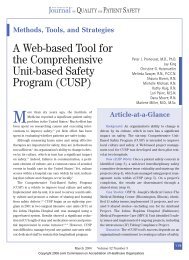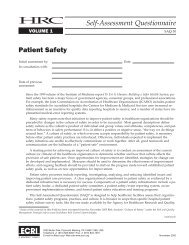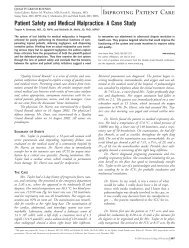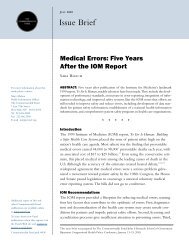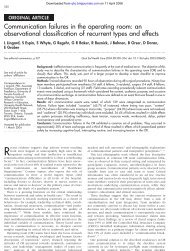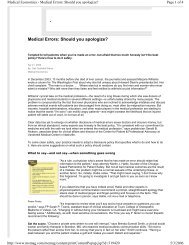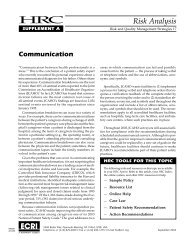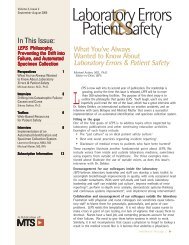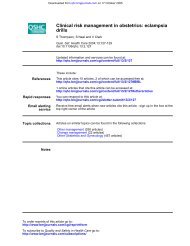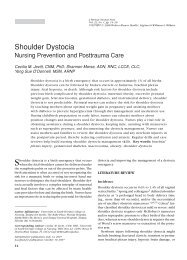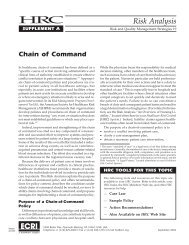From <strong>the</strong> NPUAPFigure 2.CONTENT INVENTORY FOR PRESSUREULCER PREVENTION GUIDELINES& Both internal and external, as well as legal, reviews areneeded. Comments from all internal and external reviewersneed to be compiled and acted upon.& Not all guidelines contained a clinical algorithm that <strong>the</strong>group of reviewers believed would be beneficial to include.& Guidance for implementation of guidelines was lackingin some instances. <strong>Guidelines</strong> tend to provide broad recommendationsthat can be applied to multiple patientpopulations in diverse settings. Translating guideline recommendationsinto <strong>the</strong> specific protocols, educational strategies,and practices that will work in specific settings andpopulations is often challenging. The companion implementationguidelines developed by <strong>the</strong> American MedicalFigure 3.CONTENT INVENTORY FOR PRESSUREULCER TREATMENT GUIDELINESquality ratings of individual studies to inform guideline developers.O<strong>the</strong>rs merely used a committee consensus process.& Published meta-analyses and comprehensive literature reviewsare an increasingly common source of supporting evidencefor guidelines. Many of <strong>the</strong>se reviews are excellent(eg, <strong>the</strong> Cochrane Reviews). However, a careful examinationof <strong>the</strong> methodologies used to create <strong>the</strong>se reviews is essentialbefore using <strong>the</strong>m to make recommendations for patientcare. Was <strong>the</strong> review comprehensive? Is <strong>the</strong>re any bias in <strong>the</strong>selection and review of studies? What statistical methodswere used for meta-analysis?& Rating schemas varied among guidelines. The ‘‘strengthof evidence’’ supporting a given guideline recommendationwas often based on a ‘‘design hierarchy’’ that placed <strong>the</strong>randomized controlled clinical trial at <strong>the</strong> top. The quality of<strong>the</strong> study, regardless of design, was considered by some,but not all, guideline developers. ‘‘Strength of recommendation’’rating schemes tend to address <strong>the</strong> quality and designof supporting studies while explicitly identifying and acknowledging<strong>the</strong> role of clinical expertise in providing patient care.The ‘‘strength of recommendation’’ rating often brings <strong>the</strong>science to <strong>the</strong> bedside by asking: ‘‘After a careful and comprehensiveanalysis of current science and clinical expertise, whatare <strong>the</strong> best recommendations we can offer our patients?’’ADVANCES IN SKIN & WOUND CARE & VOL. 21 NO. 5 216 WWW.WOUNDCAREJOURNAL.COMCopyright @ 2008 <strong>Lippincott</strong> <strong>Williams</strong> & Wilkins. Unauthorized reproduction of this article is prohibited.
From <strong>the</strong> NPUAPDirectors Association are an excellent example of waysto bridge this translational gap. Individual facilities andagencies are ultimately responsible for implementation,education, and continuous quality improvement.& Patient education information was included in only a fewsets of guidelines.& Seamless care between care settings is an importantconcept and was not addressed in guidelines reviewed.& Characteristics and properties of support surfaces wereincluded but could be better delineated, particularly in termsof selection of <strong>the</strong> appropriate surface for a patient with aparticular type of pressure ulcer. The NPUAP has standardizedterms and definitions related to support surfaces, and<strong>the</strong>se need to be incorporated and updated as new technologiesemerge (http://www.npuap.org/NPUAP_S3I_TD.pdf).& Mention of nutrition was lacking in most guidelines.Recommendations from those guidelines addressing nutritioncould be more specific and updated based on newerscientific evidence.& Implementation of all recommendations should be basedon patient goals and preferences.& Several ethical issues are inherent within <strong>the</strong> guidelines:truth telling and respect for individual wishes (palliative andsupportive versus healing and restorative treatment focus),distributive justice (availability of more expensive and technologicallyadvanced products in poor and underservedpopulations), distributive justice and beneficence (<strong>the</strong> responsibilityof all health care providers to provide <strong>the</strong> mostcost-effective and efficacious treatment for <strong>the</strong>ir patients,wisely utilizing resources to achieve <strong>the</strong> ‘‘most good for <strong>the</strong>greatest number’’ of patients).The FutureThe EPUAP and <strong>the</strong> NPUAP have been working on a collaborativeinternational project to develop internationalpressure ulcer prevention and treatment guidelines. Literaturesearches will be performed, evidence tables will beprepared, guidelines will be drafted, and <strong>the</strong> draft guidelinerecommendations will be distributed to wound care providersand researchers and o<strong>the</strong>r stakeholders throughout<strong>the</strong> world for input.A Web site has been developed for communication amonginternational guideline developers as <strong>the</strong>y review and analyze<strong>the</strong> scientific evidence on pressure ulcer prevention andtreatment. As literature reviews and guidelines are drafted,<strong>the</strong>y will be available on <strong>the</strong> Web site for stakeholder reviewand recommendations. The EPUAP and NPUAP Web siteshave links to <strong>the</strong> guideline Web site (http://www.EPUAP.org, http://www.NPUAP.org). It is anticipated that <strong>the</strong>senew international pressure ulcer prevention and treatmentguidelines will be completed by late 2008.Evidence supporting <strong>the</strong> international guidelines will bepresented at <strong>the</strong> World Union of Wound Healing Societies conferencein Toronto, Canada, in June 2008. Members of <strong>the</strong> internationalwound care community will be invited to comment onvarious aspects of <strong>the</strong> guidelines during this conference.&References1. Woolf SH, Grol R, Hutchinson A, Eccles M, et al. Potential benefits, limitations, and harmsof clinical guidelines. BMJ 1999;318:527-30.2. Chassin MR, Brook RH, Park RE, et al. Variations in <strong>the</strong> use of medical and surgicalservices by <strong>the</strong> Medicare population. N Engl J Med 1986;314;285-90.3. Field MJ, Lohr KN, eds. Clinical Practice <strong>Guidelines</strong>: Directions for a New Program.Washington, DC: National Academy Press; 1990.4. Global Programme on Evidence for Health Policy. <strong>Guidelines</strong> for WHO <strong>Guidelines</strong>.Geneva, Switzerland: World Health Organization; 2003 (EIP/GPE/EQC/2003.1).5. Entwistle VA, Watt IS, Davis H, et al. Developing information materials to present findingsof technology assessments to consumers. The experience of <strong>the</strong> NHS Centre for Reviewsand Dissemination. Int J Technol Assess Health Care 1998;14:47-70.6. Woolf SH. Shared decision-making: <strong>the</strong> case for letting patients decide which choice isbest. J Fam Pract 1997;45:205-8.7. Feder G. Management of mild hypertension: which guidelines to follow? BMJ 1994;308:470-1.8. Shekelle P, Eccles M, Grimshaw JM, et al. When should clinical guidelines be updated?BMJ 2001;323:155-7.9. Agency for Healthcare Policy and Research. <strong>Pressure</strong> <strong>Ulcer</strong>s in Adults: Prediction andPrevention. Clinical Practice Guideline No. 3. AHCPR Publication No. 92-0047. Rockville,MD: Public Health Service, US Dept of Health and Human Services, AHCPR; 1992.10. Agency for Healthcare Policy and Research. Treatment of <strong>Pressure</strong> <strong>Ulcer</strong>s. ClinicalPractice Guideline No. 15. AHCPR Publication No. 95-0652, Rockville, MD: Public HealthService, US Dept of Health and Human Services, AHCPR; 1994.11. European <strong>Pressure</strong> <strong>Ulcer</strong> Advisory Panel. <strong>Pressure</strong> <strong>Ulcer</strong> Prevention Guideline. Oxford:EPUAP; 1998.12. European <strong>Pressure</strong> <strong>Ulcer</strong> Advisory Panel. <strong>Pressure</strong> <strong>Ulcer</strong> Treatment <strong>Guidelines</strong>. Oxford:EPUAP; 1998.13. European <strong>Pressure</strong> <strong>Ulcer</strong> Advisory Panel Nutrition <strong>Guidelines</strong> for <strong>Pressure</strong> <strong>Ulcer</strong>Prevention and Treatment. Oxford: EPUAP; 2003.14. Wound, Ostomy and Continence Nurses Society. Guideline for Prevention and Managementof <strong>Pressure</strong> <strong>Ulcer</strong>s. WOCN Clinical Practice Guideline Series. Glenview, IL: WOCN; 2003.15. Registered Nurses’ Association of Ontario. Risk Assessment & Prevention of <strong>Pressure</strong><strong>Ulcer</strong>s. Publication No. 0-920166-57-1. Toronto, Ontario, Canada: RNAO; 2005.16. Registered Nurses’ Association of Ontario. Assessment and Management of Stage I to IV<strong>Pressure</strong> <strong>Ulcer</strong>s. Toronto, Ontario, Canada: RNAO; 2002.17. Singapore Ministry of Health. Prediction and Prevention of <strong>Pressure</strong> <strong>Ulcer</strong>s in Adults.Singapore: Singapore Ministry of Health; 2002.18. Consortium for Spinal Cord Medicine. Clinical Practice <strong>Guidelines</strong>. <strong>Pressure</strong> <strong>Ulcer</strong>Prevention and Treatment Following Spinal Cord Injury: A Clinical Practice Guideline forHealth Care Professionals. Washington, DC: Paralyzed Veterans of America; 2001.19. National Institute for Clinical Excellence. <strong>Pressure</strong> <strong>Ulcer</strong> Risk Assessment and Prevention,Including <strong>the</strong> Use of <strong>Pressure</strong>-Relieving Devices (Beds, Mattresses, and Overlays) for <strong>the</strong>Prevention of <strong>Pressure</strong> <strong>Ulcer</strong>s in Primary and Secondary Care. ISBN 1-84257-407-8.London: NICE; 2003.20. Folkedahl BA, Frantz R, Goode C. Evidence-Based Practice Guideline: Treatment of<strong>Pressure</strong> <strong>Ulcer</strong>s. Iowa City, IA: The University of Iowa Gerontological Nursing InterventionsResearch Center; 1997. Available at: http://www.guideline.gov/summary/summary.aspx?doc_id=7006. Last accessed March 18, 2008.21. American Medical Directors Association. <strong>Pressure</strong> <strong>Ulcer</strong>s, Clinical Practice <strong>Guidelines</strong>.Columbia, MD: American Medical Directors Association; 1996.22. American Medical Directors Association. <strong>Pressure</strong> <strong>Ulcer</strong> Therapy Companion, ClinicalPractice Guideline. Columbia, MD: American Medical Directors Association; 1999.23. Whitney J, Phillips L, Aslam R, et al. <strong>Guidelines</strong> for <strong>the</strong> treatment of pressure ulcers.Wound Repair Regen 2006;14:663.24. Australian Wound Management <strong>Pressure</strong> <strong>Ulcer</strong> Interest Subcommittee. Clinical Practice<strong>Guidelines</strong> for <strong>the</strong> Prediction and Prevention of <strong>Pressure</strong> <strong>Ulcer</strong>s. West Leederville, WA:Cambridge Publications; 2001. Available at: http://www.awma.com.au/publications/publications.php#clinical. Last accessed March 10, 2008.WWW.WOUNDCAREJOURNAL.COM 217 ADVANCES IN SKIN & WOUND CARE & MAY 2008Copyright @ 2008 <strong>Lippincott</strong> <strong>Williams</strong> & Wilkins. Unauthorized reproduction of this article is prohibited.



